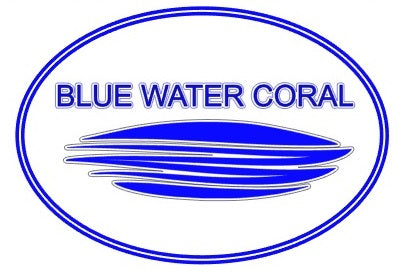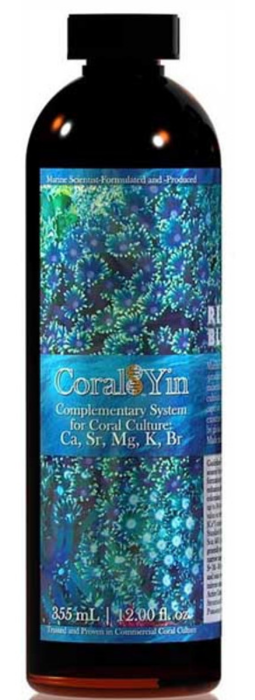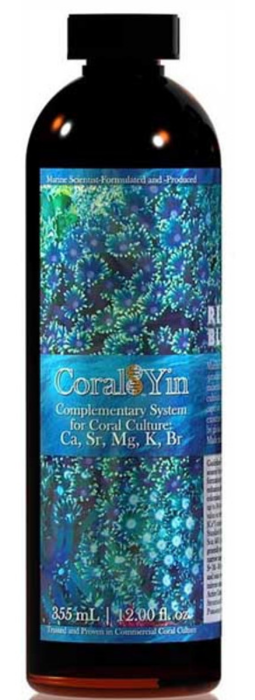Ca, Mg, Sr, K, Br Component of Coral8 Yin and Yang Complementary Coral Culture System; pair with Coral8 Yang. Coral8 system provides calcium, strontium, magnesium, potassium, and alkalinity (maximum pH value of ~8.40). A simplified approach to encouraging aragonite formation in closed circulation marine ecosystems.
Coral8 Yin
| Parameter | Value |
| Calcium | 146,600 ppm |
| Strontium | 2,932 ppm |
| Magnesium | 407 ppm |
| Bromide | 45 ppm |
| Potassium | 22 ppm |
Characteristics
Active Components: Calcium chloride, FCC; Strontium chloride, USP; Magnesium sulfate, USP; Potassium bromide, USP.
Basic Application
- 1 mL per 26.4 gallons (100 L) increases [Ca] by 1.47 ppm.
- 5 mL per 20.0 gallons (75.7 L) increases [Ca] by 9.68 ppm.
-
Reference Standard [Ca]:
-
412.1 ppm (S=35.0)
-
468.1 ppm (S=40.0)
-
In established systems, increase [Ca] up to 5% of existing ionic value daily, until desired value or reference standard is reached.
Coral8 Yang
| Parameter | Value |
| Alkalinity | 160,000 ppm |
| Max pH value attained | ~8.40 |
Characteristics
Active Components: USP-grade potassium and/or sodium salts of bicarbonate, carbonate, and borate.
Basic Application
- 1 mL per 26.4 gallons (100 L) increases alkalinity by 0.10 dKH.
- 5 mL per 20.0 gallons (75.7 L) increases alkalinity by 0.60 dKH.
- Recommended alkalinity value in established coral culture systems is ~8.0 - 9.0 dKH.
In established systems, increase alkalinity up to 1 dKH daily, until desired value or reference standard is reached.
Application
Keep out of reach of children and unauthorized persons. Avoid contact with skin, eyes, and mucous membranes. Store in a cool, dry location away from sunlight. Do not mix Coral8 Yin and Yang solutions within the same vessel, as precipitation will occur rendering the product less impactful, if not completely unusable for the intended application.
The following discussion and recommendations are made expressly for recirculating systems. Laboratory application may proceed as required by study objectives. Review Disclaimer at bottom of page prior to using this or other Captiv8 Aquaculture product(s).
The rate of ion depletion due to cohort uptake is driven by various chemical and physical factors which are unique to each independently-operating recirculating system, and which are constantly changing as cohort biomass increases and decreases.
Monitoring (daily) the system's concentrations of element(s) provided by this formulation and referencing apparent changes in cohort biomass will enable User to adjust dosing of this formula to suit system requirements, improving overall effectiveness and resulting in less wasted solution.
Recommended is diluting an appropriate volume of these solutions into a larger volume of purified water (with a purity of at least 98%), and applying the diluted solutions to the system with an automated dosing system. Dosing frequency is directly proportional to stability of ionic concentrations and, resultantly, continuous cohort biomass growth. A 1 - 10 s drip interval provides adequate ionic stability, and is recommended.
If no automated dosing system is available, then apply solutions manually each day. Dosing frequency is directly proportional to stability of ionic concentrations and, resultantly, continuous cohort biomass growth. Dosage volume per 24 h is divided by the dosing frequency*.
It is not recommended that these formulations be dosed fewer than four times weekly.
Recommended: Do not increase parameter concentration by more than 5% per 24h period in systems with existing cohorts. Aside from emergencies (e.g. excessive nutrient content in an active system, greatly depressed or excessive salinity, etc.), gradual changes in water composition are generally tolerated better by aquatic organisms than are rapid changes.
Coral8 Yin:
Reference Standards: 1 mL Isol8 Ca diluted in 26.4 gal. (100 L) water yields 1.47 ppm increase of [Ca].
To calculate required solution volume for known parameter differential:
- Multiply net water volume (L) by actual [Ca] (ppm).
- Multiply net water volume (L) by desired [Ca] (ppm).
- Subtract product of Step 1 from product of Step 2.
- Divide difference of Step 3 by 146.60. Answer is mL sol’n required to achieve desired [Ca] in situ.
Coral8 Yang:
If using with automated dosing apparatus, then do not introduce organic materials into the direct vicinity of the Coral8 Yang drip entry point, as these may saponify. Do not apply in close proximity to sessile invertebrates or developing finfish embryos. Monitor cohort for signs of distress when increasing average system alkalinity and pH values, and decrease or halt dosing if distress is noticed. Do not exceed maximum pH value of 8.40 in recirculating seawater systems.
*Example: If dosage volume per 24 h = 10 mL and dosing frequency = 4, then dose 2.5 mL per event.


